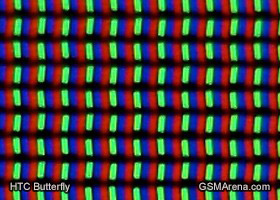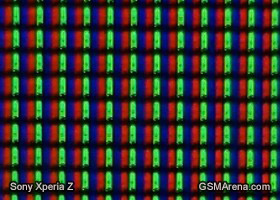HTC Butterfly review: The droid monarch
The droid monarch
Controls
Above the screen, we have the proximity and ambient light sensors to the right of the earpiece and the 2.1MP 1080p front-facing camera on the left. Once again, HTC has put in a wide-angle front-facing camera, which lets you fit more into the frame when doing video chats (there's no native video call support).

Some sensors and the front-facing camera flank the earpiece
Underneath the screen, we find the three controls typical of HTC droids. The haptic-enabled capacitive touch Back, Home and Task switcher keys are well-spaced and very responsive.

Three capacitive touch buttons sit below the screen
The left side of the HTC Butterfly is completely bare, while the right side holds the volume rocker. Unfortunately, this is yet another Android flagship to come without a camera key.




There's just a single button on the sides of the Butterfly
At the top we find a secondary microphone, the 3.5mm audio jack, and a small plastic flap under which reside the microSD card slot and the microSIM card slot.
The Power/Lock key was also placed here, which makes it pretty inconvenient to use. Instead of putting it on one of the sides of the Butterfly, where it would have been easy to reach with your thumb or index finger, HTC has placed the most used hardware button on the place that is the hardest to reach. Unless you are Shaquille O'Neil, you'll probably need to use a second hand or risk dropping the phone every time you lock/unlock it.
To make matters worse the button is almost flat with the surrounding plastic, making it very hard to press. It's not the first time HTC has made a blunder like that either - the HTC Windows Phone 8X had a similar fate and so did the One X/X+ (although the buttons on those two were at least easier to press, and not in the exact center of the top panel).
As usual, at the bottom of the phone, you will see the mouthpiece and the microUSB port, which is used for data transfers, charging, and thanks to its MHL support, TV-out. With an MHL adapter you'll be able to output 1080p content to your HDTV directly from your phone, so purchasing one is probably worth it. Unfortunately, we found the plastic cover over the microUSB port very stiff and hard to open, which is not ideal considering how often you'll use it.


The microUSB port is next to the primary microphone
The back of the HTC Butterfly features the 8MP camera lens and the LED flash right next to it.
The other elements at the back are the loudspeaker grille near the bottom and the Beats audio logo right above it. You should keep in mind though that the audio enhancements are only available when you have connected a pair of headphones and not when using the loudspeaker itself.




The camera lens, the LED flash and the loudspeaker are at the back
The HTC Butterfly is powered by a non-user-replaceable 2020 Li-Ion battery. HTC didn't provide official endurance ratings for it and the relatively low capacity (it's the smallest unit of the three 5" 1080p smartphones we've seen so far) did have a lot of people worried about its endurance.
As it turns out though, the HTC Butterfly posted a very respectable 45h score in our dedicated battery test. This means you'll have to charge the smartphone every 45 hours if you do an hour of calling, video watching and web browsing per day.

HTC Butterfly battery test scorecard
Class-leading 1080p display
We now come to the star of the show. The 5" 1080p screen is probably the main reason you are looking at the HTC Butterfly and the third generation Super LCD won't let you down. The 441 ppi pixel density means you won't be able to discern individual pixels even if you press the screen against your nose, but that's by far not all the display has going for it.
The HTC Butterfly LCD also offers great contrast and nicely saturated colors, to go with its extremely wide viewing angles. The viewing angles, together with the high resolution make everything appear as if painted on the screen - an effect we really appreciate.
As you can see in the table below, the screen is pretty bright as well. The blacks aren't as deep as those of the AMOLEDs out there, but still great in LCD terms.
| Display test | 50% brightness | 100% brightness | ||||
| Black, cd/m2 | White, cd/m2 | Black, cd/m2 | White, cd/m2 | |||
| HTC Butterfly | 0.14 | 173 | 1200 | 0.45 | 501 | 1104 |
| Sony Xperia Z | - | - | - | 0.70 | 492 | 705 |
| Oppo Find 5 | 0.17 | 176 | 1123 | 0.51 | 565 | 1107 |
| Sony Xperia S | - | - | - | 0.48 | 495 | 1038 |
| Samsung I9300 Galaxy S III | 0 | 174 | ∞ | 0 | 330 | ∞ |
| HTC One X | 0.15 | 200 | 1375 | 0.39 | 550 | 1410 |
| Nokia Lumia 920 | - | - | - | 0.48 | 513 | 1065 |
| Nexus 4 | 0.22 | 314 | 1447 | 0.45 | 608 | 1341 |
| LG Optimus G | 0.14 | 197 | 1445 | 0.33 | 417 | 1438 |
| Apple iPhone 5 | 0.13 | 200 | 1490 | 0.48 | 640 | 1320 |
We also have a photo of the HTC Butterfly display as seen by our digital microscope. The pixels are the same size as on the Xperia Z, but even here you can see how much "livelier" they are.


HTC Butterfly vs Sony Xperia Z display matrices
Sunlight legibility is not exactly perfect, but is good enough to not cause any usability issues.
Sunlight contrast ratio
-
Nokia 808 PureView
4.698 -
Samsung I9300 Galaxy S III
3.419 -
Samsung Omnia W
3.301 -
Samsung Galaxy S
3.155 -
Nokia N9
3.069 -
Samsung Galaxy Note
2.970 -
HTC One S
2.901 -
Samsung Galaxy S II
2.832 -
Samsung Galaxy S II Plus
2.801 -
Huawei Ascend P1
2.655 -
Nokia Lumia 900
2.562 -
Sony Xperia Z
2.462 -
Samsung Galaxy S III mini
2.422 -
Motorola RAZR i
2.366 -
Apple iPhone 4S
2.269 -
HTC One X
2.158 -
Nokia N8
2.144 -
Oppo Find 5
2.088 -
BlackBerry Z10
2.051 -
Apple iPhone 4
2.016 -
Sony Ericsson Xperia ray
1.955 -
Samsung Galaxy Camera
1.938 -
HTC Butterfly
1.873 -
Sony Xperia V
1.792 -
Sony Xperia U
1.758 -
LG Optimus 4X HD
1.691 -
HTC One V
1.685 -
LG Optimus Vu
1.680 -
HTC Desire V
1.646 -
LG Optimus 3D
1.542 -
Nokia Asha 302
1.537 -
Nokia Lumia 610
1.432 -
Gigabyte GSmart G1355
1.361 -
HTC Desire C
1.300 -
LG Optimus L7
1.269 -
LG Optimus L9
1.227 -
Meizu MX
1.221 -
Sony Xperia E dual
1.203 -
Samsung Galaxy Pocket
1.180 -
Sony Xperia tipo
1.166 -
Samsung Galaxy mini 2
1.114
Overall, the Butterfly screen is the pinnacle of mobile display evolution so far, but it still leaves some room for improvement. LG and Samsung would really need to came close to perfection to beat that.
Reader comments
- AnonD-737671
- 15 Feb 2018
- sxs
Guys how to make 4G of my Htc butterfly can anyone suggest what to do?
- zy
- 21 Nov 2015
- X3$
have microsd slot, microsim
- zy
- 21 Nov 2015
- X3$
no 4g



